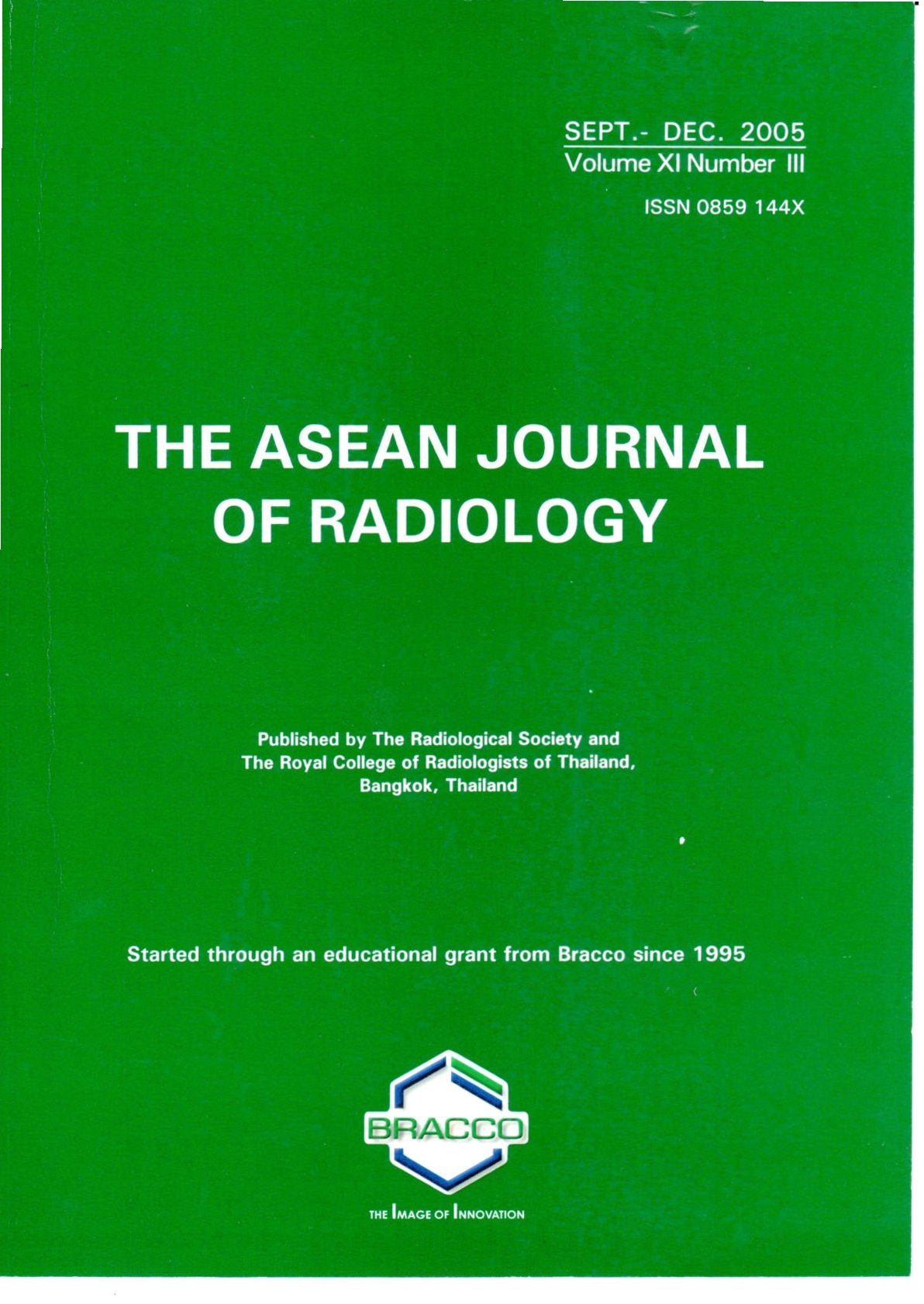PATIENT AND STAFF EXPOSURE DURING CARDIAC CATHETERIZATION
Abstract
The purpose of this study was to estimate both patient and staff radiation doses during coronary angiography and percutaneous transluminal coronary angioplasty with stenting procedures by direct measurement and to compare these results with data from the literatures. Radiation doses from 159 patients have been studied, 101 of which had undergone coronary angioplasty and 58 percutaneous transluminal coronary angioplasty with stenting. All procedures were undertaken on biplane angiocardiographic system (Phillips Integris). The system performed under automatic exposure control using continuous fluoroscopy and cine frame rate of 12.5 frames s-1. Dose-area product values and fluoroscopy times were collected for each patient. Median values for dose—area product were 39.3 Gy cm2 for coronary angiography and 146.7 Gy cm2 for percutaneous transluminal coronary angioplasty with stenting. Median fluoroscopy time was 3.8 min and 17.7 min for coronary angiography and percutaneous transluminal coronary angioplasty with stenting, respectively. Comparison showed that patient dose-area product values for coronary angiography were lower than other studies and fluoroscopy time values were comparable. But the patient dose-area product values and fluoroscpy time for percutaneous transluminal coronary angioplasty with stenting were higher than other studies. The cardiologist received a median dose of 253.9 uGy and 264.5 uGy to the lens of the eye, and 261.3 uGy and 256.5 uGy to the skin level of thyroid, per procedure of coronary angiography and percutaneous transluminal coronary angioplasty with stenting respectively. Recommendations for optimization of patient doses are given.
Downloads
Metrics
References
Sources and Effects of Ionizing Radiation. United Nations Scientific Committee on the Effects of Atomic Radiation. UNSCEAR 2000 Report to the General Assembly with Scientific Annexes. New York: United Nations, 2000.
Balter S, Shope TB. Syllabus: A categorical course in physics: physical and technical aspects of angiography and interventional radiology. 81st Scientific Assembly, Dec 1995. RSNA’ 95 Scientific Program 1995: 1-258.
World Health Organization. Efficacy and radiation safety in interventional radiology. Geneva: World Health Organization, 2000.
United States Food and Drug Administration (FDA). Avoidance of serious X-ray induced skin injuries to patients during fluoroscopically guided procedures.Medical Bulletin 1994; 24: 7-17.
Joint WHO/ISH/CE workshop on efficacy and radiation safety in interventional radiology; 1995 October 9-13; Munich-Neuherberg, Germany-Germany: Bundesamt fur Starhlenschutz, BfS-ISH-178/97, 1997.
Vano E, Gonzalez L, Fernandez JM, Guibelalde E. Patient dose values in interventional radiology. BrJ Radiol 1995; 68: 1215-20.
Padovani R, Novario R, Berardi G. Optimization in coronary angiography and percutaneous transluminal coronary angioplasty. Radiat Prot Dosim 1998; 80: 303-6.
Broadhead DA, Chapple C-L, Faulkner K, Davies ML, McCallum H. The impact of cardiology on the collective effective dose in the North of England. BrJ Radiol 1997; 70: 492-7.
Zorzetto M, Bernardi G, Morocutti G, Fontanelli A.Radiation exposure to patients and operators during diagnostic catheterization and coronary angioplasty. Cathet Cardiovasc Diagn 1997; 40: 348-51.
Widmark A, Fosmark H, Einarsson G, et al. Guidance levels in the Nordic Countries: A preliminary report for selected interventional procedures. Radiat Prot Dosim 2001; 94: 133-5.
Cusma JT, Bell MR, Wondrow MA, Taubel JP, Holmes DR. Real-time measurement of radiation exposure to patients during diagnostic coronary angiography and percutaneous interventional procedures. J Am Coll Cardiol 1999; 33: 427-35.
Clark AL, Brennan AG, Robertson LJ, McArthur JD. Factors affecting patient radiation exposure during routine coronary angiography in the tertiary referral centre. Br J Radiol 2000;73:184-9.
Tsapaki V, Kottou S, Vano E, etal. Patient dose values in a dedicated Greek cardiac center. BrJ Radiol 2003; 76: 726-30.
Van De Putte S, Verhaegen F, Taeymans Y, Thierens H. Correlation of patient skin doses in cardiac interventional radioloy with dose-area product. Br J Radiol 2000; 73: 504-13.
Neofotistou V. Review of patient dosimetry in cardiology. Radiat Prot Dosim 2001; 94: 177-82.
Neofotistou V, Venon E, Padovani R et al. Preliminary reference levels in interventional cardiology. European Radiology 2003.
International Commission on Radiological Protection. Recommendations of the International Commission on Radiological Protection, ICRP publication 60. Oxford: Pergamon, 1991.
Bernardi G, et al. Clinical and technical determinants of the complexity of percutaneous transluminal coronary angioplasty procedures: analysis in relation to radiation exposure parameters. Cath Cardiov Interv 2000; 51: 1-9.
Padovani R, Bernardi G, Malisan MR, Vano E, Morocutti G, Fioretti PM. Patient dose related to the complexity of interventional cardiology procedures. Radiat Prot Dosim 2001; 94: 189-92.
Vano E, Gonzalez L, Ten JI, Fernandez JM. Guibelalde E, Macaya C. Skin dose and dose-area product values for interventional cardiology procedures. BrJ Radiol 2001; 74: 48-55.
Vano E, Goicolea J, Galvan C, Gonzalez L, Ten J, Macaya C. Skin radiation injuries in patients following repeated coronary angioplasty procedure. Br J Radiol 2001; 74: 1023-31.
Downloads
Published
How to Cite
Issue
Section
License
Copyright (c) 2023 The ASEAN Journal of Radiology

This work is licensed under a Creative Commons Attribution-NonCommercial-NoDerivatives 4.0 International License.
Disclosure Forms and Copyright Agreements
All authors listed on the manuscript must complete both the electronic copyright agreement. (in the case of acceptance)













